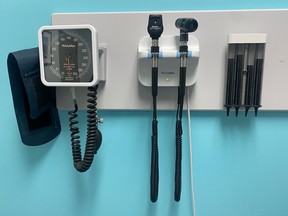As of 2021, Canada had 22.5 nurse practitioners for every 100,000 people, compared to a ratio of 61.1 per 100,000 in the United States.
Article content
Ontario is grappling with a worsening primary care crisis — 2.2 million residents and counting are without a family doctor — and nurse practitioners have entered the spotlight.
The provincial government has announced $110 million in funding to expand primary-care teams, many of them led by or including nurse practitioners. Critics say that while welcome, that amount is a drop in the bucket compared to the number of people without primary care.
Advertisement 2
Article content
Article content
There are more than 5,000 nurse practitioners in Ontario, the most of any Canadian province or territory. The numbers grow every year.
What can nurse practitioners do?
Nurse practitioners are registered nurses who have additional graduate education and practice experience and have met exam requirements set by the College of Nurses of Ontario.
For decades, rural and remote “outpost nurses” worked in place of physicians in the far north and elsewhere. They were the forerunners of nurse practitioners.
The role of nurse practitioner was not formalized in law in Ontario until 1997. Their scope of practice — meaning what they can legally do — has been expanding ever since.
They can independently diagnose and treat illnesses and can order and interpret diagnostic tests, including X-rays, ultrasounds, blood tests, MRIs, CT scans and more. They can also prescribe a broad range of medications, including controlled substances, and can set and cast fractures and dislocated joints, making them key players in providing primary care, especially at a time when there is a shortage of family physicians practising comprehensive primary care.
Advertisement 3
Article content
What can’t nurse practitioners do?
Nurse practitioners can do many of the same things as family physicians, but something they can’t do is to bill directly to the Ontario Health Insurance Plan (OHIP). Nurse practitioners, who work in clinics, hospitals, long-term care homes, home care and prisons, among other places, are paid salaries. Physicians, on the other hand, can bill OHIP directly for services they do in their offices.
In recent months, as the primary-care shortage has worsened, clinics have popped up around the province where the public can pay to access care from nurse practitioners. Among the first was Ottawa’s South Keys Clinic, which has been charging patients $400 per year to access nurse practitioners.
Critics argue those businesses contravene the spirit and the law of medicare by having people pay for services typically covered under provincial health plans. Ontario Minister of Health Sylvia Jones says such clinics are exploiting a “loophole” and calls on the federal government to act. It remains unclear how or whether that will be done.
Perry Brodkin, a former lawyer with the Ontario Health Insurance Plan, said Ontario’s Commitment to the Future of Medicare Act does not prohibit nurse practitioners from owning and operating nurse practitioner clinics that bill patients. The Canada Health Act, he said, only applies to provinces and territories, not to nurse practitioners or physicians.
Advertisement 4
Article content
The rise of ‘autonomous’ nurse practitioner clinics
Michelle Acorn, a nurse practitioner and professor who is CEO of the Nurse Practitioners’ Association of Ontario (NPAO), said the organizations knew of about 20 autonomous nurse practitioner clinics in the province now, many opened in response to demand from members of the public desperate for primary care.
“Nurse practitioners now are independently starting to own and operate access points for primary care because of community demand,” Acorn said. “This is about need, not greed.”
That includes Sudbury, where an estimated 10,000 people are set to lose primary health care due to retirements.
How can more nurse practitioners be added to the health system?
Acorn said nurse practitioners are perfectly placed to fill growing gaps in the primary care system. She said her organization was in talks with the province about “accessible funding models.” She said other provinces had alternative funding arrangements that had brought more nurse practitioners into the primary care system, something she would like Ontario to follow.
Advertisement 5
Article content
“We are looking at different funding models,” she said. “We want to make sure people have access right now.”
There are also calls for the province to fund more than the current 25 nurse practitioner-led clinics in Ontario. Numerous groups, including several in Ottawa, have applied for funding to set up clinics, some of which include nurse practitioners and others that are led by them but have not yet been approved.
Why has the issue of nurse practitioners in primary care come to a head now?
The expanded scope of practice for nurse practitioners — the number of services they can offer — and the growing numbers of nurse practitioners, come at a time when Ontario and the rest of Canada face an unprecedented primary-care crisis. Doctors are retiring, changing specialties or not choosing family medicine because they believe that job is underpaid and mired in paperwork. Nurse practitioners are widely considered an important factor in increasing access to primary care, but funding has not kept up with demand.
As of 2021, Canada had 22.5 nurse practitioners for every 100,000 people, compared to 61.1 nurse practitioners per 100,000 in the United States.
Recommended from Editorial
-

Who should be vaccinated against measles? Questions rise as cases increase
-

School board trustees vote to allocate two positions for Muslim, Arab equity coaches
Article content




